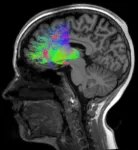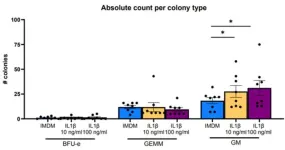(Press-News.org) Scientists have known for decades that the classic symptoms of schizophrenia, such as jumping to conclusions or difficulty adjusting to new information, can be attributed to poor communication between the cerebral cortex and the thalamus, known as the brain’s central switchboard. By measuring brain cell activity between these two regions as volunteers completed ambiguous tasks, a team of Tufts University School of Medicine and Vanderbilt University School of Medicine researchers found a way to use someone’s sensitivity to uncertainty as a diagnostic tool.
In a study published November 7 in the journal Cell Reports Medicine, the researchers show that people with schizophrenia generate distinct neural patterns when asked to make decisions based on conflicting information. The work offers one of the first biological tests to assess whether someone is prone to inflexible thinking and, by monitoring changes in these patterns, a new way to measure whether treatments are working.
“Our goal was to derive a biomarker for executive dysfunction in schizophrenia, which only emerged when patients were taxed by an uncertain task,” says physician-scientist Michael Halassa, an associate professor of neuroscience and psychiatry at Tufts University School of Medicine who co-led the study with Neil Woodward, a neuropsychologist at Vanderbilt University School of Medicine. “We make decisions that are hierarchical in nature all the time as humans—meaning that we often need to account for misinformation at different levels—but this breaks down in schizophrenia and here is a way we can begin measuring that attribute.”
Over the course of evolution, the human brain has developed ways to “vote” on which bits of information are most relevant when making decisions. For example, if you go to your favorite restaurant but your meal isn’t the quality you’ve come to expect, you may think the chef is out or having a bad night, but it doesn’t prevent you from coming back. In contrast, a person with schizophrenia may be unable to consider the evidence that the past 20 or 30 visits were great and will no longer want to return to the restaurant.
Animal studies have shown that this behavior is driven by deficits in how the part of the forebrain that helps animals make sense of complex inputs (the dorsolateral prefrontal cortex) interfaces with a subcortical region associated with conflict resolution and decision making (the mediodorsal thalamus). Informed by the animal data, the research team developed a series of cognitive and imaging tests to better understand this neural circuitry in humans to establish more accurate diagnostics for patients.
The scientists asked about 40 study participants—a mixture of neurotypical individuals and patients with schizophrenia—to correctly choose a target’s location based on a sequence of cues that can be made more or less conflicting. For healthy people, performance was very good even when the conflict was high. People with schizophrenia had comparable behavior to controls when there was little conflict, but they made many more errors with conflict levels that were tolerated well by controls.
“When you look at the behavior, there's an increased susceptibility to sensory noise, so the patients with schizophrenia don't do as well when things become more ambiguous,” said Anna Huang, a research assistant professor of psychiatry and behavioral sciences at Vanderbilt and co-first author of the study. “These results correlated with thalamus and frontal cortex deficits that we could capture in brain activity readouts, predicting a person’s ability to process conflicting information in perceptual as well as memory tasks."
The researchers plan to validate their findings by replicating the methods with a wider range of subjects receiving brain scans as they process ambiguous cues. They also plan on administering hierarchical tasks to subjects, akin to the restaurant example above. The study is part of a wider research initiative the Halassa Lab is pursuing to link neural activity to data that can be interpreted for clinical benefit.
Also contributing to this study were Ralf Wimmer, research assistant professor of neuroscience and co-first author, and Norman Lam, postdoctoral fellow, from Tufts University School of Medicine, as well as Sahil Suresh, a student in the MD/PhD Medical Scientist Training Program at Tufts University School of Medicine and the Graduate School of Biomedical Sciences at Tufts University.
Complete information on authors, funders, methodology, and conflicts of interest is available in the published paper. The content is solely the responsibility of the authors and does not necessarily represent the official views of the funders.
END
People with schizophrenia show distinct brain activity when faced with conflicting information
Researchers introduce a biomarker to indicate whether someone is struggling with the inflexible thinking associated with the disorder
2024-11-07
ELSE PRESS RELEASES FROM THIS DATE:
Climate change: Significant increase in carbon dioxide emissions from private aviation
2024-11-07
Annual emissions of carbon dioxide (CO2) from private aviation increased by 46% between 2019 and 2023, according to an analysis published in Communications Earth & Environment. The results also show that some individuals who regularly use private aviation may produce almost 500 times more CO2 in a year than the average individual, and that there were significant emissions peaks around certain international events, including COP 28 and the 2022 FIFA World Cup.
Private aviation is highly energy-intensive, emitting significantly more CO2 per passenger than commercial flights, but is used by approximately 0.003% ...
Planting trees in the Arctic could make global warming worse, not better, say scientists
2024-11-07
Tree planting has been widely touted as a cost-effective way of reducing global warming, due to trees’ ability to store large quantities of carbon from the atmosphere. But, writing in the journal Nature Geoscience, an international group of scientists argue that tree planting at high latitudes will accelerate, rather than decelerate, global warming.
As the climate continues to warm, trees can be planted further and further north, and large-scale tree-planting projects in the Arctic have been championed by governments and ...
Finding function for noncoding RNAs using a new kind of CRISPR
2024-11-07
Genes contain instructions for making proteins, and a central dogma of biology is that this information flows from DNA to RNA to proteins. But only two percent of the human genome actually encodes proteins; the function of the remaining 98 percent remains largely unknown.
One pressing problem in human genetics is to understand what these regions of the genome do—if anything at all. Historically, some have even referred to these regions as “junk.”
Now, a new study in Cell finds that some noncoding RNAs are not, in fact, junk—they are functional and play an important role in our cells, including in cancer and human development. Using CRISPR technology that ...
Neurodevelopment in the first 2 years of life following prenatal exposure to maternal SARS-CoV-2 Infection
2024-11-07
About The Study: In this longitudinal cohort study of multiple aspects of child neurodevelopment between ages 6 and 24 months, negligible associations between prenatal exposure to SARS-CoV-2 infection and child outcomes were observed. Follow-up research is warranted to determine whether these predominantly null effects persist into later childhood.
Corresponding Author: To contact the corresponding author, Gerald F. Giesbrecht, PhD, email ggiesbre@ucalgary.ca.
To access the embargoed study: Visit our For The Media website at this link https://media.jamanetwork.com/
(doi:10.1001/jamanetworkopen.2024.43697)
Editor’s ...
Racial disparities in genetic detection rates for inherited retinal diseases
2024-11-07
About The Study: Results from this study highlight a lower genetic detection rate for Black patients than for white patients with inherited retinal diseases. This supports a concern that the current development of inherited retinal disease therapeutics is highly dependent on the ability to identify the genetic cause of disease.
Corresponding Author: To contact the corresponding author, K. Thiran Jayasundera, M.D., email thiran@med.umich.edu.
To access the embargoed study: Visit our For The Media website at this link https://media.jamanetwork.com/
(doi:10.1001/jamaophthalmol.2024.4696)
Editor’s Note: Please see the article for additional information, including ...
Stem cells shed insight into cardiovascular disease processes
2024-11-07
When thinking about the immune system, most people think about B and T cells and how they can be trained to recognize pathogens, preventing re-infections. Besides this “adaptive” immune system, we also have an “innate” immune system which acts as first line defense against e.g. bacteria and viruses. The textbook view is that the innate immune system is non-specific so that it’s response always follows the same pattern, even for recurring infections. However, research published today in Stem Cell Reports provides evidence ...
New study: Plastics pollution worsen the impacts of all Planetary Boundaries
2024-11-07
“It’s necessary to consider the full life cycle of plastics, starting from the extraction of fossil fuel and the primary plastic polymer production” says lead article writer Patricia Villarrubia-Gómez at Stockholm Resilience Centre.
Plastics are not as safe and inert as previously thought. The new research article written by an international team of researchers uses the planetary boundaries framework to structure the rapidly mounting evidence of the effects of plastics on the environment, health and human wellbeing.
500 million tons of plastics are now produced yearly but only nine percent get recycled globally. Plastics are everywhere: ...
Long-term risks from prostate cancer treatment detailed in new report
2024-11-07
The risks of adverse effects and complications from treatment for prostate cancer are substantial and continue for years after treatment ends. The largest comprehensive analysis reporting long-term risks from such treatment relative to the risks faced by a control group of untreated men has just been published in the journal JAMA Oncology.
In the 12 years following treatment, men whose initial treatment was a prostatectomy (removal of all or part of the prostate) had a risk of urinary or sexual complications ...
Does more virtual care mean more low-value care? Study suggests no
2024-11-07
Before 2024 ends, Congress will decide whether to keep or change rules about telehealth, or let them expire. And even though the decision will focus on Medicare’s payment for virtual patient care, it will likely impact telehealth access for people with other kinds of health insurance too.
Now, a new University of Michigan study suggests that policymakers can rest easier about one of the top worries about telehealth: that virtual care will drive up the use of tests and scans that patients don’t need, wasting money and resources.
In fact, the study shows that low-value care didn’t rise faster at primary care practices that used telehealth the most, compared with those ...
City of Hope Research Spotlight, October 2024
2024-11-07
City of Hope® Research Spotlight offers a glimpse at groundbreaking scientific and clinical discoveries advancing lifesaving cures for patients with cancer, diabetes and other chronic, life-threatening diseases. Each spotlight features research-related news such as recognitions, collaborations and the latest research defining the future of medical treatment.
This roundup highlights the biology behind our sense of smell, real-world data that can be used to refine esophageal cancer treatment guidelines, a potential new approach to treating patients with type 2 diabetes, a new way to target pancreatic cancer ...
LAST 30 PRESS RELEASES:
Normalizing blood sugar can halve heart attack risk
Lowering blood sugar cuts heart attack risk in people with prediabetes
Study links genetic variants to risk of blinding eye disease in premature infants
Non-opioid ‘pain sponge’ therapy halts cartilage degeneration and relieves chronic pain
AI can pick up cultural values by mimicking how kids learn
China’s ecological redlines offer fast track to 30 x 30 global conservation goal
Invisible indoor threats: emerging household contaminants and their growing risks to human health
Adding antibody treatment to chemo boosts outcomes for children with rare cancer
Germline pathogenic variants among women without a history of breast cancer
Tanning beds triple melanoma risk, potentially causing broad DNA damage
Unique bond identified as key to viral infection speed
Indoor tanning makes youthful skin much older on a genetic level
Mouse model sheds new light on the causes and potential solutions to human GI problems linked to muscular dystrophy
The Journal of Nuclear Medicine ahead-of-print tip sheet: December 12, 2025
Smarter tools for peering into the microscopic world
Applications open for funding to conduct research in the Kinsey Institute archives
Global measure underestimates the severity of food insecurity
Child survivors of critical illness are missing out on timely follow up care
Risk-based vs annual breast cancer screening / the WISDOM randomized clinical trial
University of Toronto launches Electric Vehicle Innovation Ontario to accelerate advanced EV technologies and build Canada’s innovation advantage
Early relapse predicts poor outcomes in aggressive blood cancer
American College of Lifestyle Medicine applauds two CMS models aligned with lifestyle medicine practice and reimbursement
Clinical trial finds cannabis use not a barrier to quitting nicotine vaping
Supplemental nutrition assistance program policies and food insecurity
Switching immune cells to “night mode” could limit damage after a heart attack, study suggests
URI-based Global RIghts Project report spotlights continued troubling trends in worldwide inhumane treatment
Neutrophils are less aggressive at night, explaining why nighttime heart attacks cause less damage than daytime events
Menopausal hormone therapy may not pose breast cancer risk for women with BRCA mutations
Mobile health tool may improve quality of life for adolescent and young adult breast cancer survivors
Acupuncture may help improve perceived breast cancer-related cognitive difficulties over usual care
[Press-News.org] People with schizophrenia show distinct brain activity when faced with conflicting informationResearchers introduce a biomarker to indicate whether someone is struggling with the inflexible thinking associated with the disorder







